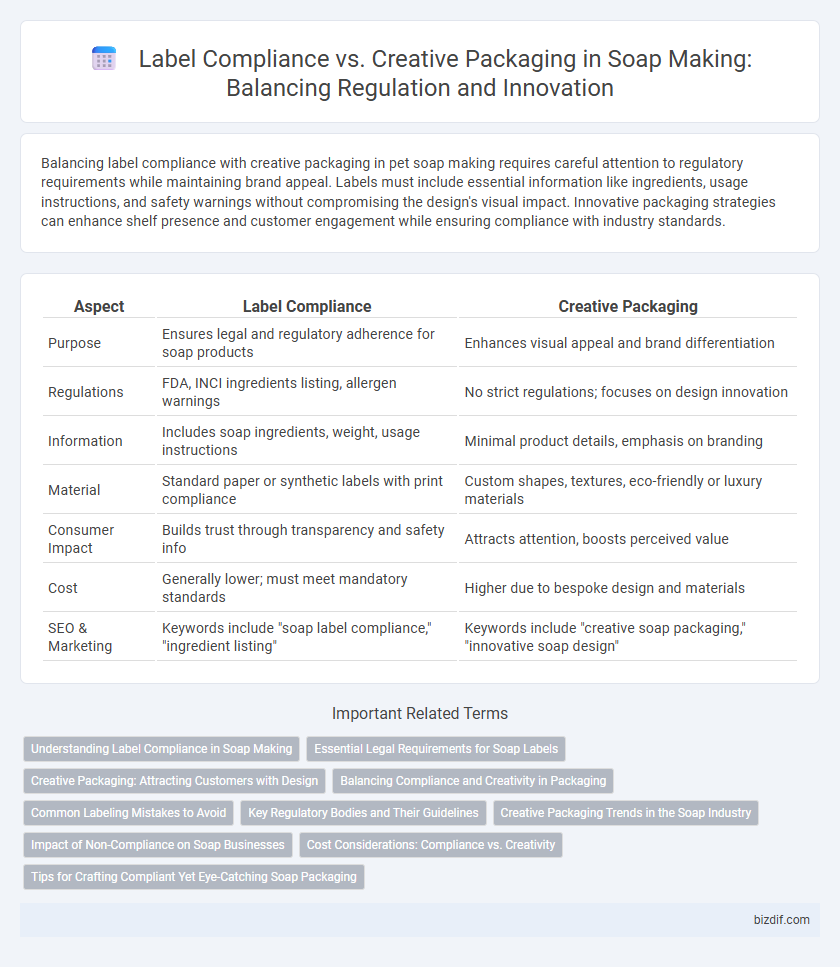Balancing label compliance with creative packaging in pet soap making requires careful attention to regulatory requirements while maintaining brand appeal. Labels must include essential information like ingredients, usage instructions, and safety warnings without compromising the design's visual impact. Innovative packaging strategies can enhance shelf presence and customer engagement while ensuring compliance with industry standards.
Table of Comparison
| Aspect | Label Compliance | Creative Packaging |
|---|---|---|
| Purpose | Ensures legal and regulatory adherence for soap products | Enhances visual appeal and brand differentiation |
| Regulations | FDA, INCI ingredients listing, allergen warnings | No strict regulations; focuses on design innovation |
| Information | Includes soap ingredients, weight, usage instructions | Minimal product details, emphasis on branding |
| Material | Standard paper or synthetic labels with print compliance | Custom shapes, textures, eco-friendly or luxury materials |
| Consumer Impact | Builds trust through transparency and safety info | Attracts attention, boosts perceived value |
| Cost | Generally lower; must meet mandatory standards | Higher due to bespoke design and materials |
| SEO & Marketing | Keywords include "soap label compliance," "ingredient listing" | Keywords include "creative soap packaging," "innovative soap design" |
Understanding Label Compliance in Soap Making
Understanding label compliance in soap making ensures that all product labels meet regulatory requirements set by bodies such as the FDA and the EPA, which govern ingredient disclosure, safety warnings, and proper usage instructions. Accurate labeling protects consumers by providing essential information on allergens, shelf life, and active ingredients, reducing the risk of legal issues and recalls. Adhering to these standards safeguards brand reputation while allowing creative packaging to enhance visual appeal without compromising mandatory information.
Essential Legal Requirements for Soap Labels
Soap labels must comply with essential legal requirements including ingredient disclosure, product identity, net quantity, manufacturer details, and safety warnings as mandated by regulatory bodies like the FDA and FTC. Creative packaging must not obscure or alter mandatory label information, ensuring legibility and accuracy to avoid misbranding or consumer deception. Adhering to these standards safeguards both consumer trust and legal accountability in soap product marketing.
Creative Packaging: Attracting Customers with Design
Creative packaging in soap making leverages vibrant colors, unique shapes, and eco-friendly materials to captivate customers and enhance brand recognition. Innovative design elements such as textured surfaces and custom typography elevate product appeal and differentiate soaps in a competitive market. Eye-catching packaging not only draws attention on crowded shelves but also fosters a memorable customer experience that drives repeat purchases.
Balancing Compliance and Creativity in Packaging
Effective soap packaging must balance strict label compliance with creative design to meet regulatory standards while attracting consumers. Labels require accurate ingredient lists, safety information, and certifications to ensure legal adherence and consumer trust. Integrating visually appealing, unique packaging elements enhances brand identity without compromising mandatory label clarity.
Common Labeling Mistakes to Avoid
Common labeling mistakes in soap making include omitting required ingredient lists, failing to display accurate weight or volume, and neglecting proper allergen warnings as mandated by regulatory agencies like the FDA or EU Cosmetics Regulation. Incorrect font size or unclear text can also lead to non-compliance, reducing consumer trust and risking legal penalties. Ensuring label compliance while maintaining creative packaging demands a careful balance between aesthetics and adherence to labeling standards.
Key Regulatory Bodies and Their Guidelines
Key regulatory bodies such as the U.S. Food and Drug Administration (FDA), the European Chemicals Agency (ECHA), and Health Canada enforce strict guidelines on soap labeling to ensure consumer safety and transparency. Compliance requires accurate ingredient disclosure, allergen warnings, and claims substantiation, directly impacting packaging design constraints. Balancing creative packaging with regulatory mandates involves integrating clear labeling elements without compromising brand aesthetics or consumer appeal.
Creative Packaging Trends in the Soap Industry
Creative packaging trends in the soap industry emphasize sustainability and unique sensory experiences, incorporating biodegradable materials and innovative textures to elevate brand appeal. Eye-catching designs featuring natural motifs and minimalist aesthetics align with consumer preferences for eco-friendly and artisanal products. Custom shapes, bold color palettes, and tactile elements create a memorable unboxing experience that differentiates products in a competitive market.
Impact of Non-Compliance on Soap Businesses
Non-compliance with label regulations in the soap-making industry can lead to substantial financial penalties, product recalls, and damaged brand reputation. Creative packaging that overlooks mandatory label information risks misleading consumers and attracting regulatory scrutiny, ultimately hindering market access and consumer trust. Ensuring label compliance while maintaining appealing packaging design is critical for safeguarding soap businesses from legal liabilities and sustaining competitive advantage.
Cost Considerations: Compliance vs. Creativity
Balancing label compliance and creative packaging in soap making involves careful cost considerations, as regulatory adherence often requires specific labeling materials and printing standards that can increase expenses. Creative packaging, while offering market differentiation and brand appeal, may demand higher costs for customized designs, specialty inks, and unique shapes or textures. Manufacturers must evaluate the trade-offs between meeting mandatory compliance costs and investing in innovative packaging to maximize both legal adherence and consumer engagement.
Tips for Crafting Compliant Yet Eye-Catching Soap Packaging
Ensure soap packaging meets FDA requirements by clearly displaying ingredient lists, net weight, and warnings to maintain label compliance. Incorporate unique design elements such as vibrant colors, textured materials, and eco-friendly packaging to create visually appealing products that attract customers. Use durable, water-resistant labels and fonts that remain legible despite moisture exposure, balancing regulatory standards with creative aesthetics.
Label Compliance vs Creative Packaging Infographic

 bizdif.com
bizdif.com